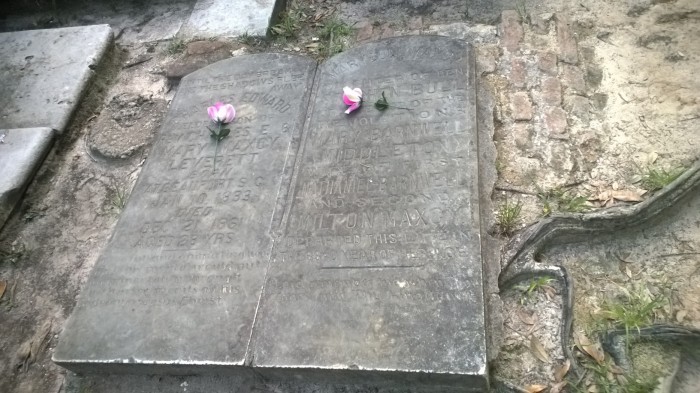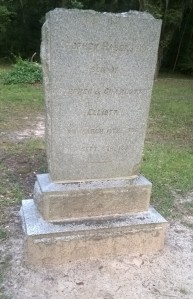At the end of part one on Old Sheldon Church, I promised to pick up a copy of the The Leverett Letters to confirm the source and contact the South Carolina Historical Marker Program. I did both but will save the details about the marker for the final installment of what I am now dubbing the Old Sheldon Church Trilogy.
In 2000, the University of South Carolina Press released the edited collection The Leverett Letters featuring correspondence from 1851-1868 by a prominent family in Beaufort. The family’s patriarch Rev. Charles Leverett served the small congregation of Sheldon Church from 1846-1858.[1] He and his wife Mary had nine children, two of which were adopted, and maintained a home on prominent Bay Street. They also owned a plantation, Canaan, and thirty-four people. The family’s influence extended across the state, including Columbia, the city on which my dissertation primarily focuses. Two of their sons attended South Carolina College, better known as the University of South Carolina today. The family also maintained a home called “The Farm” on the edge of the capital city. Additionally, two Columbia cemeteries served as the final resting place for several family members.[2]
After retiring from Sheldon in 1858, Rev. Leverett continued to provide services at Canaan for his family and slaves. He also became temporary rector of St. Helena’s Church Chapel of Ease, a site I also visited on my research trip but about which I have yet to blog.[3] Mary probably thought more highly of Sheldon as she complained that St. Helena was “very limited socially” and comprised of a flock “considered as heathens by outsiders.”[4] Like most planters and whites, when Beaufort came under Federal control early in the Civil War, most of the family fled to “The Farm,” a sixty-four acre tract in north Columbia near the South Carolina Lunatic Asylum. They remained there from spring of 1862 until after the war.[5] When word reached Columbia that Beaufort native Robert Smalls stole the Confederate ship The Planter, Mary divulged to her son Milton that “Mr. McKee told your father one of the negroes was his” but did not disclose the name.[6] Smalls, as well as his former owner, will be the subject of future posts as I visited nearly a half a dozen sites affiliated with the Reconstruction era politician while in Beaufort. In the meantime, watch a portion of Comedy Central’s Drunk History interpretation of the theft, which aired at the end of July.
Back to the Leveretts.
The Leveretts regained control of Canaan by February 1866, but two Northerners, who had paid the delinquent property taxes, lived in the Bay Street home. Milton ran Canaan, planting subsistence crops and contracting with freedmen as local Freedmen’s Bureau policy dictated.[7] After describing his challenges with “the trial of free negro labor” and requesting his mother hire workers in Columbia for Canaan, Milton revealed Sherman and Union troops had not be responsible for the church’s destruction. He also wrote of the overall good mood in Beaufort in early 1866:
“Sheldon Church is not burnt down. It has been torn up inside somewhat but it could be repaired. A good many Beaufort people are living in Beaufort in any vacant house or story they can get, and I am surprised to see them so cheerful . . . Beaufort is not in near so bad a condition as we supposed. The Bay St. if anything looks better and our house and Mr Jno Smith’s look neater than any I have seen, they have been recently painted white.”[8]
While Milton and his mother debated whether they should try to purchase the Bay Street home from the Northerners or wait for the federal government to return it, Milton confessed that Canaan shared a similar fate as Sheldon Church. When he returned to the family property, Milton discovered nearby freedmen had dismantled and removed parts of the outbuildings. He also continued to “see fragments of Sheldon Church all about” Beaufort. [9]
It would have been easy for the family to vilify Sherman. The matriarch Mary provided a vivid account of the February night that Columbia burned after Sherman’s troops descended upon the city. Three of the four sons served in the Confederacy, including Milton and Charles, the latter of which served in Virginia under “Redeemer” Gov. Wade Hampton III. Hampton, whose election in 1876 returned white rule to South Carolina and ended Reconstruction in the state, will appear frequently across the blog as it continues to develop. But the Leverett family had a vested interest in learning accurate details of the church’s demise. In addition to Rev. Leverett’s professional connection with the church, the family’s history remained intertwined with Sheldon in a variety of ways. In 1858, daughter Anne married Louis McPherson DeSausure Jr. there. After son Edward’s death around Christmas of 1861, the family buried him at Sheldon.[10] Mary reminded Milton “that grave, that dear grave in old Sheldon Churchyard—I can never leave that.”[11]
Twelve years before Edward’s death, Charles and Mary interred an infant son Evelyn there, with a gravestone reading “Not lost. Only gone before.”[12]
Just a year after laying Edward to rest, Milton attended the burial of six-year old Stephen Elliot at Sheldon, yet another tie the family maintained to the graveyard.[13]
Knowing two Leverett children were buried beneath the peaceful Spanish moss of the church, the family shared details of Sheldon’s dismantling with one another and counted on Milton to relay authentic accounts. I find the Leverett letters incredibly convincing, but did their publication change the narrative about the destruction of Sheldon Church in the twenty-first century? Join me for the conclusion of the trilogy in a blog not so far far away.
[1] Frances Wallace Taylor, Catherine Taylor Matthews, and J. Tracy Power, eds., The Leverett Letters: Correspondence of a South Carolina Family, 1851-1868 (Columbia: University of South Carolina Press, 2000), 5, 70; Rev. Charles Edward Leverett, “Rev. Charles Edward Leverett to His Son Edward, November 23, 1853,” in The Leverett Letters: Correspondence of a South Carolina Family, 1851-1868, ed. Frances Wallace Taylor, Catherine Taylor Matthews, and J. Tracy Power (Columbia, S.C.: University of South Carolina Press, 2000), 22. Hereafter letters from edited collection cited as “in The Leverett Letters.”
[2] Taylor, Matthews, and Power, The Leverett Letters, 1–2, 5, 455.
[3] Ibid., 70.
[4] “Mary Maxcy Leverett to Her Son Edward, Aug. 26th 1858,” in The Leverett Letters, 73.
[5] Taylor, Matthews, and Power, The Leverett Letters, 99–100, 119, 421.
[6] “Mary Maxcy Leverett to Her Son Milton, May 20th, 1862,” in The Leverett Letters, 129.
[7] Taylor, Matthews, and Power, The Leverett Letters, 402.
[8]“Milton Maxcy Leverett to His Mother, February 3, 1866,” in The Leverett Letters, 403–404.
[9] Ibid., 404; “Milton Maxcy Leverett to His Mother, February 7, 1866,” in The Leverett Letters, quote 405.
[10] Taylor, Matthews, and Power, The Leverett Letters, 3–4, 91, 100.
[11] “Mary Maxcy Leverett to Her Son Milton, May 20th, 1862,” 129.
[12] Taylor, Matthews, and Power, The Leverett Letters, 455; “The Inscriptions on the Gravestones at Sheldon Church,” The South Carolina Historical and Genealogical Magazine 18, no. 4 (October 1, 1917): 182.
[13]“Milton Maxcy Leverett to His Mother, September 16, 1862,” in The Leverett Letters, 170; “The Inscriptions on the Gravestones at Sheldon Church,” 182.


Pingback: Return of The Leverett Letters: a New Marker and a Battle for Local Memory | Reconstructing Reconstruction
Hi admin do you need unlimited articles for your site ?
What if you could copy content from other blogs, make it unique and publish on your site
– i know the right tool for you, just type in google:
kisamtai’s article tool
LikeLike
If you are interested in topic: earn online cash poker – you should read about Bucksflooder first
LikeLike